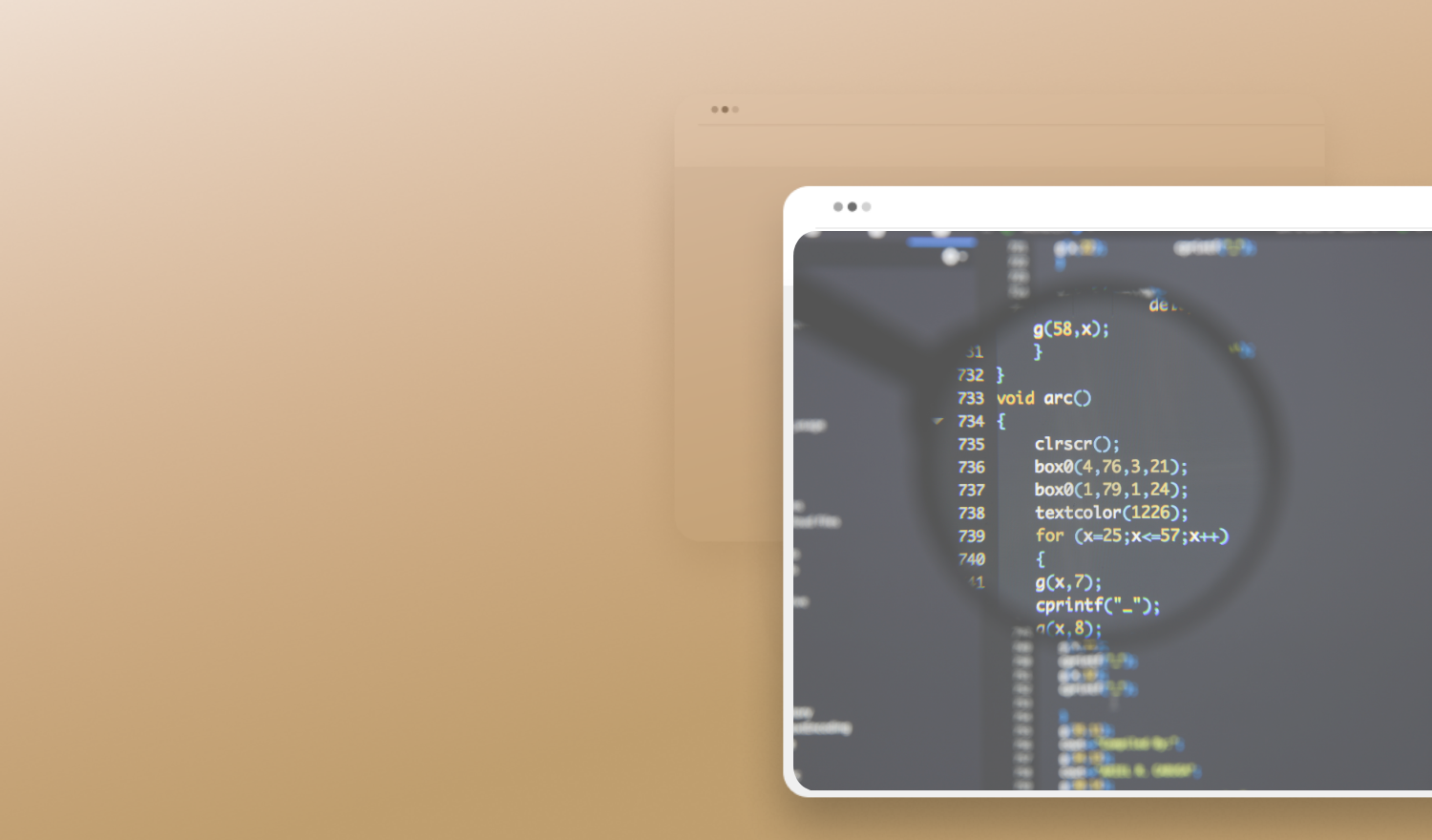navigation

Retailers pioneered the online shopping experience. They instinctively understand the importance of an easy product search and a smooth checkout workflow. It’s only understandable that these retailers look for wholesale websites that offer an experience like the one they provide. The best wholesale websites offer the convenience of B2C commerce with the functionality that business buyers need.
Unfortunately, too often wholesale supplier websites fail to deliver. Either products are difficult to find, the site lacks transparency into supply levels, or buyers can’t self-serve. Buyers deserve better.
But wholesale sites don’t need to deliver ho-hum customer experiences. By understanding the needs of your customers and following the lead of the best websites for wholesale, you can create a wholesale webshop that improves the customer experience on the front end and streamlines back-office processes too.
Keep reading to discover the elements of a great wholesale eCommerce website design and see real-life B2B wholesale website examples that deliver results.
How B2B eCommerce Helps Wholesalers
When you have a wholesale store online, you never close for business. It’s a 24/7/365 sales rep. And that continual availability is important if you run a global wholesale operation or if your retail customers purchase before or after hours. And that’s just the start of the benefits of an online wholesale website.
Customization helps wholesale retailers online
One wholesaler may supply many different verticals. For example, Gala Imports supplies the pharmaceutical, food, beverage, and candle-making industries with glass containers.

With a website that features products by category associated with the vertical, they make finding just the right product for the buyer’s needs much easier. And face it, if you are a wholesaler with tens of thousands of SKUs, you need to make product discovery as easy as possible.
Some B2B eCommerce platforms even allow you to set up multiple websites from a single instance. That means you could create a website for each vertical.
Even if you don’t take personalization to that extreme, the best wholesale websites allow you to offer each customer their own personal catalog of products they purchase complete with their pre-negotiated prices.
Tailoring the customer experience to the individual customer isn’t possible without technology. But when wholesale B2B goes online, digitalization transforms the impossible into the possible.
Localization benefits buyers and wholesalers
With a digital wholesale storefront, you can control the products displayed by location, as well as the language and currency used. Localization allows you to only show the products available in the customer’s area. So, if you wholesale products that are restricted in certain areas, this keeps customers from placing orders for products you can’t deliver.
For example, if you wholesale CBD products in the United States, you need to control the sale of products by state. With localization, you can show your retailers in Wyoming only those products with a THC of 0.3% or less while showing your Virginia retailers products with up to 0.5% THC.
Buyers see only products available to them using the language, currency, and shipping options appropriate for their location.
Sellers don’t waste time canceling orders for unavailable products and they don’t risk losing hard-earned goodwill.
Reduces friction in the buying process
To the retail buyer, placing the order is a job and it’s a job they want to do as quickly and efficiently as possible. Wholesale stores online make purchasing much easier for the buyer, thereby removing friction from the process.
The best wholesale B2B online stores allow buyers to upload CSV files, fill out quick order forms, and reorder from their purchase history.
Modern buyers want to self-serve as much as possible and savvy wholesalers offer them this experience.
Automate processes for improved efficiency
Digital commerce for wholesalers also improves back-office efficiency. There’s no need for order entry and with integrated systems, order data flows from the eCommerce website through the order management system, and tracking information flows back through to the buyer.
With pricing rules and a pricing engine, you can even automate the quoting and price negotiation processes.
Forrester shares how top midmarket brands use technology
Discover the real-life case studies from leading business sellers.
Benefits of a Modern eCommerce Website for Wholesale
In addition to improving efficiency and the selling process (which are two tremendous benefits), wholesale websites and B2B marketplaces help establish the brand, support marketing efforts, and aid in growing the company.
Branding
Your brand is more than just a set of colors, a logo, and maybe a tagline or motto. To your customers, your brand is the entire experience they have with your products. From searching your catalog, to placing the order, to placing your products on the shelf your brand is more than the visual elements that appear on a screen.
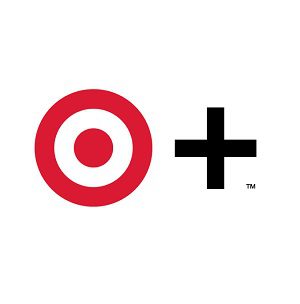
The role of eCommerce in the wholesale sector includes supporting branding strategies and efforts. When a wholesale website incorporates user and customer reviews, it helps tell the brand story. When you let your company personality shine through your website, you help customers connect with your brand.
Your online wholesale website helps build relationships, establish trust, and build your brand identity.
Marketing
It takes considerable marketing to capture a lead, nurture it, convert the lead to a sale, and then maintain a relationship after the sale.
The best wholesale websites are marketing engines. They offer complete product information, how-to videos, offer case studies, and show how their products meet the needs of their target audience.
Growth
Wholesale websites provide an effective tool for growth. You can enter new markets and geographic locations without hiring additional sales representatives or opening a new office. Through website inquiries, you may find growth opportunities you didn’t know existed. Because digital interactions are highly measurable, it’s easier to perform A/B testing and discard strategies and messages that don’t deliver while focusing on your best-performing tactics.
How To Start a Wholesale Website Project?
Before you issue an RFP or start comparing eCommerce platforms, make a list of wholesale websites that offer the functionality you want to replicate. Wholesale store examples don’t necessarily need to offer the same products or even operate in the same industry. However, it might help to look at distributor website examples, as wholesaling and distributing are similar sales models. Then take your wholesale website examples and start sharing them with your digital team.
If this is your first digital presence, you’ll need a team that includes promoters from marketing, sales, customer service, and IT at a minimum.
Building a team
Your team members will represent all areas of the company either impacted by a move to digital commerce or as users of the website on a regular basis. If the project involves implementing multiple systems, then those system users should be included as well. For example, if the website is used as an order management system, order fulfillment team members should be included too.
The team should be led by a member with experience implementing digital projects. They should be up-to-date on technology and understand your industry and your customers.
Look for partners
Chances are, you don’t have the internal resources to pull off a wholesale website project in-house. So, look for partners that have experience with wholesale stores online and have completed projects including wholesale online shopping sites.
Show them examples of wholesaler websites that you like. Digital agencies and eCommerce consultants bring a wealth of skill and knowledge to the table and can be a great asset.
Set MVP requirements
The minimum viable product (MVP) approach is a proven way to test and validate your eCommerce project while minimizing the financial commitment and risk.
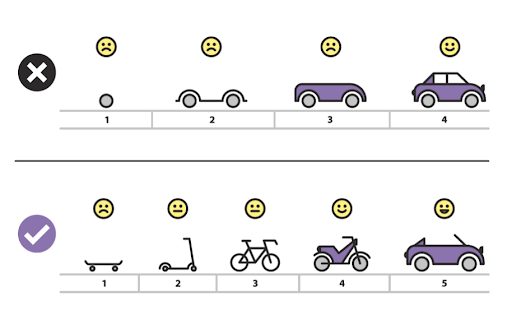
This approach optimizes development resources and speeds the time to market. It also helps maintain focus on the customer and the iteration process creates a continuous improvement loop.
Decide the elements for your eCommerce MVP and use this as the basis for creating your RFP.
Reduce risk and save costs with an MVP approach
Create a wholesale website that's right for you and your customers.
Create the RFP
Once you know what should be included in the MVP for your online wholesale website, you can start to define the functionality you’ll need to bring your project to life. This includes features for the front-end design of the wholesale website, administrative capabilities, workflow adaptability, and marketing tools. You’ll also want to specify your needs for security, how the solution must be deployed (Cloud, in-house, hybrid), integration, API, and compatibility with your existing IT structure.
Compare Platforms
Once you’ve created your shortlist of vendors, you can compare their offerings against your needs. You may ask for a list of wholesale websites powered by their solution. If they haven’t created wholesale websites specifically, you may want to ask about their experience in B2B eCommerce for distributors as the needs of wholesalers and distributors are similar.
What Are the Essential Wholesale Website Elements?
The best wholesale websites feature a clean design, searchable product database, customizable catalogs and price lists, and responsive design. And that’s just on the front-end! On the back-end, you want maximum flexibility, easy administration, and a solution that’s open for integration.
Clean easy-to-use design
Your website must offer an uncluttered, clean modern design. It must render flawlessly on all platforms using the most popular browsers.
Walton’s wholesales the supplies that meat processors need to season, pack, and ship meat. Their website features logical product categories, clean drop-down menus, and access to quick order forms right from the home page. The design is clean and navigation is easy.
Complete product information
Wholesale buyers want as much information as they can get without picking up the phone or sending an email. A wholesale webshop should provide the information a buyer needs to make a product decision. This includes visibility into stock levels, so integration with your ERP or WMS is important.
Customizable pricing
Because B2B prices are generally negotiated on a per-customer basis, wholesale supplier websites must be able to handle hundreds or thousands of price lists. If you use tiered pricing or rule-based pricing, you need a pricing engine that can automatically generate the right price for the customer.
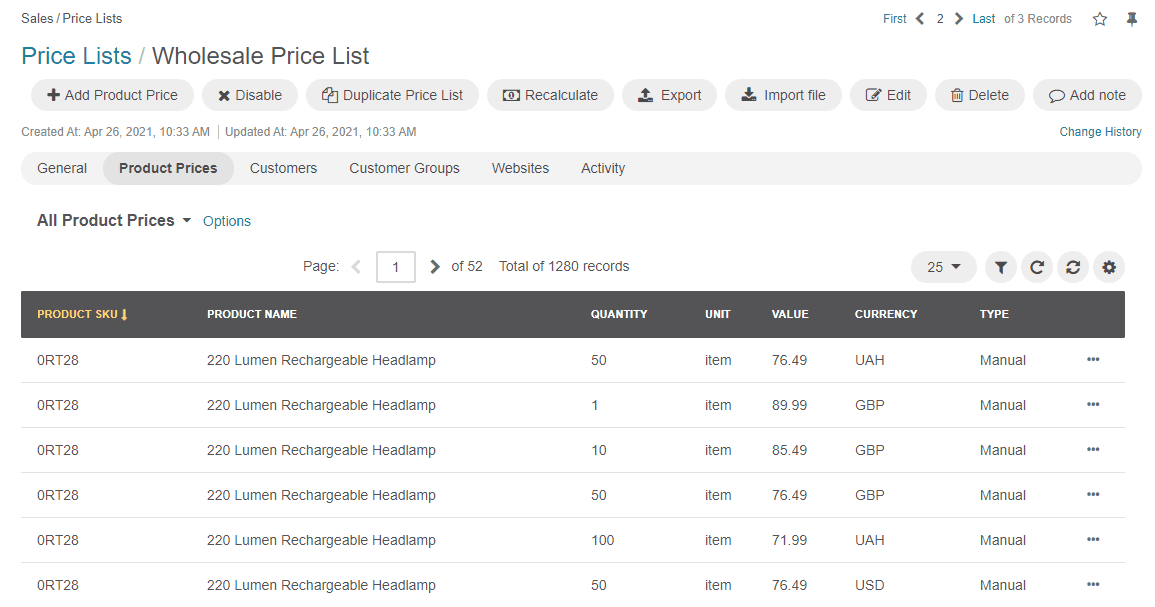
Customizable workflows
Because not every wholesale customer is the same, not every wholesale eCommerce transaction should be processed the same.
For example, you may want to offer a credit check and net 30 terms for large, regular customers and demand payment at the time of order for one-off or small customers. Your website should allow for customizable workflows and conform the software to the company and not the company to the software.
User-based roles and permissions
More than one person is generally involved in B2B buying decisions. By allowing each customer to manage the roles and permissions for their account, they can customize account access to their needs. Look for a website that can accommodate customers that involve multiple departments, offices, or teams in their buying process.
Quick order entry
Placing an order is a job for the buyer. Your website should allow them to do their job as quickly and painlessly as possible. Quick order forms, one-page checkout workflows, and integration with EDI for eCommerce remove friction from the actual process of placing the order. Look for an eCommerce platform that allows CSV file uploads or integrates easily with customer ordering systems and punch-out catalogs.
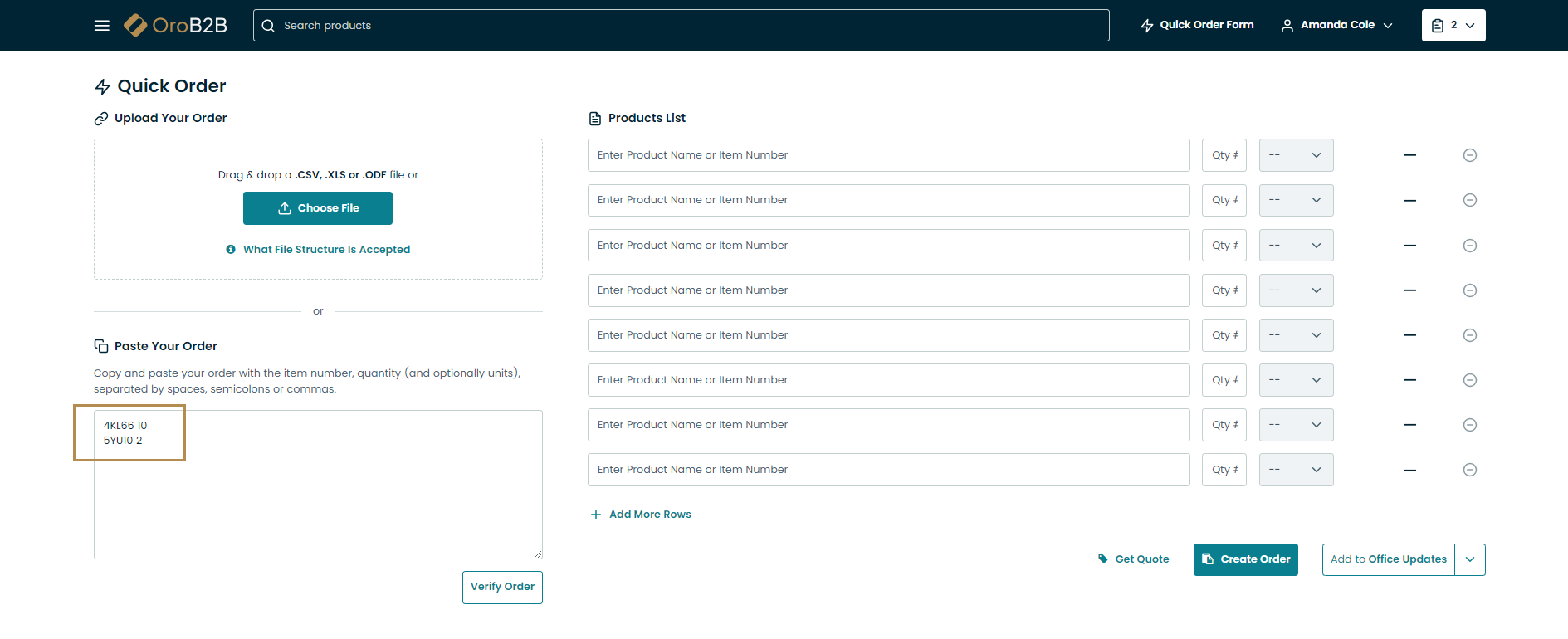
Support multiple websites
Often, wholesale online shopping sites cater to a specific market or vertical. Unless your backend can handle multiple front-end websites, administration can be a nightmare. Look for an eCommerce solution that lets you manage multiple websites on different domains all from a single backend.
Automated backend workflows
Just as you want the ability to customize workflows on the front-end, you want to customize and automate backend activities as well. For example, by automating contracts you ensure prices and terms are accurate. Automating the request for quote and quote to cash processes avoids data entry errors and allows you to provide higher levels of service.
Marketing tools
Your website should do more than handle orders, it should increase order value and drive sales too. A backend that easily creates upsell and cross-sell suggestions and enables the design of landing pages to support content marketing or paid advertising turns the website into an engine for marketing.
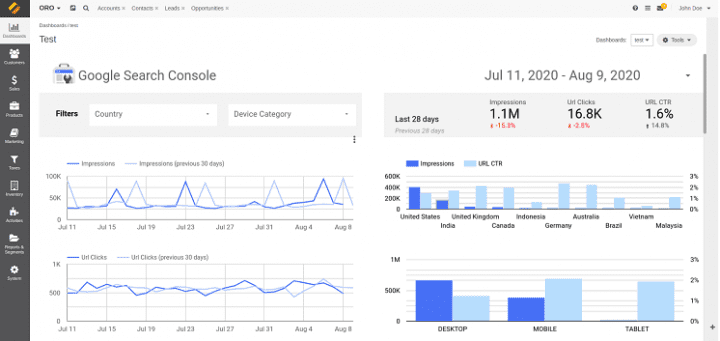
Open API and integration
Your website won’t stand alone. It needs to integrate and communicate with other systems and solutions. Look for a robust set of APIs for easy connectivity and the ability to integrate with your existing architecture, particularly your ERP.
Security
Data and transactions must be secure. Any website that handles credit card information must be PCI DSS compliant. In addition, personal data must be secured in accordance with a slew of governmental regulations. Look for a solution that provides the highest levels of security for data and transaction processing.
Examples of the Best Wholesale Websites
Wholesalers carry everything from salts to supplies for pets and electronics and accessories. Here are wholesale store examples from brands that are innovating, improving customer experiences, and streamlining operations with B2B eCommerce.
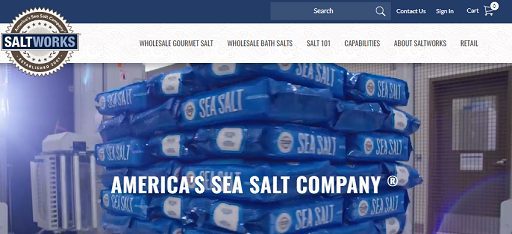
SaltWorks
SaltWorks supplies salts to food processors, manufacturers, restaurants, and individual retail customers. They now use a single website that conforms to the needs of both B2B and B2C buyers. Their website displays custom pricing for B2B customers who log in and retail prices for B2C buyers looking to buy smaller quantities.
The site displays products by category and even allows visitors to filter results within the category. For example, visitors can filter everything from Epsom salts to Himalayan pink sea salt by grain or flake size.
Commercial buyers get a workflow customized to their needs, while retail customers get an Amazon-like B2C experience.

Petra Industries
Petra Industries wholesales consumer electronics to tens of thousands of retailers. They are a leading innovator in a field that thrives on innovation.
Their website contains thousands of SKUs that are searchable by part number, keywords, vendor SKU, or Petra SKU. Each product page contains detailed product information as well as downloadable sell sheets and warranty information. Sellers get all the information they need to populate their own websites and resources to help build their business.
Petra offers dropshipping services to certain e-tailers and the website easily handles dropship and bulk purchases. Even the onboarding process for new customers can be completed right from the website.
The Petra Industries website smooths back-office operations and improves the customer experience on the front-end as well. It meets the needs of the wholesaler and the customer, making it one of the best websites for wholesale on the net.
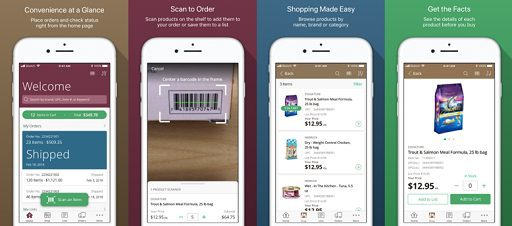
Animal Supply
Animal Supply is one of the leading wholesale suppliers of pet products in the United States. They operate with multiple regional warehouses and a number of legacy ERPs acquired during the time their growth was through acquisition.
Today, when an Animal Supply customer logs into the website, they get personalized price lists for the products available in their region. There’s no confusion caused by displaying products that aren’t available in the customer’s service area.
In addition to a totally responsive design, the wholesale website is supported by a web app to make ordering from a smartphone even easier.
The Animal Supply website reduces the complexity of the company’s network of ordering systems, ERPs, and warehouse systems and makes the customer experience better than ever. Customers get can place orders anytime and the company benefits from streamlined operations.
How to Choose the Best Wholesale eCommerce Platform?
When picking the best wholesale eCommerce platform, you want a solution that is built from the ground up for the intricacies of B2B selling.
Look for a solution that offers the most flexibility as well as the greatest functionality out of the box. You want an eCommerce platform that doesn’t require you to change your workflows just to conform to the software. Instead, you want a B2B wholesale eCommerce platform that lets data and processes flow the way you want.
Built for the long haul
Wholesale eCommerce is around to stay. Look for a platform that meets your needs today but scales as you grow and enables expansion in the future. Options that can handle B2B, B2C, B2G, or B2anything business models allow you to pivot as conditions change.
Open source versus proprietary solutions
In general, open-source applications will offer you greater flexibility and extendibility. When the code is visible, it is generally supported by a large community of developers and users. Often, with open source code, you don’t need to reinvent the wheel when you need to make a change. Chances are, someone else has already done it.
Open source code is also more secure. Because vulnerabilities are public, they are quickly identified and corrected.
Proprietary solutions may limit the integrators and partners available and can slow the time to market.
Cloud or on-premise?
Some proprietary B2B eCommerce platforms only offer a cloud-based option. If the nature of your business requires you to maintain control and security of your data and servers, a cloud option isn’t a viable solution.
Solutions that are at home in the cloud and in your secure server room offer the most flexibility in deployment.
What is the best B2B eCommerce platform?
Explore the comparison table of the top platforms on the market.
Oro’s Experience as a Wholesale eCommerce Platform
Oro, Inc. creates technology products to empower B2B brands. OroCommerce is built with the needs of wholesalers in mind. Instead of running from the complexity of B2B, Oro embraces the challenge.
For 10 years, wholesalers, manufacturers, and distributors have used OroCommerce to improve their customer experiences and simplify order processing. It has been deployed on-premises and in the cloud. OroCommerce can manage commerce in a headless architecture or provide full front- and back-end functionality in a more traditional eCommerce application.
Wholesalers from Australia to France and Singapore to South America are creating wholesale sites that set their brands apart from the competition and they are using OroCommerce to get the job done.
Wholesale Websites Are the Future of Wholesale
B2C websites will continue to set a high bar for B2B sellers. Corporate buyers continue to look for frictionless experiences they enjoy when shopping for their own needs.
Smart wholesalers continually evolve and improve their online experience. By creating websites designed for the needs of wholesale buyers, sellers make purchasing as easy as possible.
Using technology to automate routine tasks frees your human assets to cultivate and nurture customer relationships.
Your wholesale eCommerce website must do just more than take orders, it should enable your brand to continually evolve to meet customer needs.
Let us help you with your digital strategy to grow your business.
Questions and Answers
What is the difference between a wholesale website and a retail website?
Wholesale websites are customized to the needs of the buyer. Each buyer may see a different product catalog and price list depending on their buying preferences. A retail website shows all products at the same price.
What makes a great wholesale website?
The best websites for wholesale businesses take the pain out of purchasing. They offer a clean and responsive design, feature advanced search options, offer complete product information, and give buyers the self-serve experience they want.
If you don’t have a wholesale website, where do you start?
The minimum viable product (MVP) approach makes the most of the time and money you invest in validating your website strategy. By starting small, you can get to market quickly and then test, validate, and reiterate to continually improve your offering. Speaking with an experienced eCommerce consultant is a great place to start your MVP discussion.
How long does it take to create a wholesale website?
The amount of time it takes to create a wholesale website depends on the amount of development and integration work that needs to be done. For the fastest time to market, look for a B2B-focused eCommerce platform that offers the most functions right out of the box.
What is the difference between a self-serve portal and a wholesale website?
Some companies offer an online portal to the customer’s account in their distribution ERP software. These self-serve portals allow customers to see their order history, get copies of invoices, and get tracking information on current orders. A complete wholesale eCommerce website not only offers a self-serve portal, but it enables online ordering.
